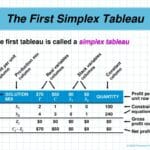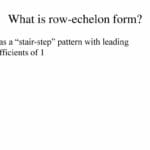Ever feel lost in a sea of numbers? A stem and leaf display can be your compass, transforming raw data into an easily understandable visual representation. This guide will equip you with the knowledge and techniques to construct and interpret these displays, revealing hidden patterns and valuable insights. Whether you’re a student, researcher, or business professional, this powerful tool can simplify your data analysis process.
What is a Stem and Leaf Display?
A stem and leaf display, also known as a stemplot, provides a visual snapshot of your data’s distribution, much like a histogram. It cleverly organizes numerical data by splitting each value into a “stem” (the leading digit(s)) and a “leaf” (the trailing digit). Think of it as organizing books on a shelf: the stems are the categories (like genres), and the leaves are the individual books. This structure allows you to quickly identify clusters, gaps, and potential outliers in your data, revealing valuable insights that might otherwise remain hidden.
Building Your Own Stem and Leaf Plot
Creating a stem and leaf plot is surprisingly straightforward. Here’s a step-by-step guide:
1. Sorting Your Data
Begin by arranging your data in ascending order (smallest to largest). This is like arranging books alphabetically on a shelf—it makes finding what you need much easier. This ordered list forms the foundation of your display.
2. Defining Stems and Leaves
Next, dissect each data point into its stem and leaf components. Typically, the stem is the tens digit (or hundreds digit for larger numbers), and the leaf is the units digit. For example, in the number 37, the stem is 3, and the leaf is 7. For larger numbers like 157, the stem could be 15 and the leaf 7, or the stem could be 1 and the leaf 57. The best approach depends on the range and distribution of your data. If you’re a student working on a sample DBQ, this visual approach can help you analyze data within your historical context.
3. Constructing the Stem Column
Write the stems vertically in ascending order, forming the backbone of your display. Include all stems within your data range, even if a stem has no corresponding leaves. This ensures an accurate depiction of the distribution.
4. Adding the Leaves
For each data point, write its leaf next to the corresponding stem. When a stem has multiple leaves, write them in ascending order next to each other. This reveals clusters of data—the longer the row of leaves, the more data points fall within that range.
Example: Putting it all together
Let’s illustrate with the dataset: 12, 15, 21, 23, 23, 28, 31, 34, 42, 45.
Key: 1 | 2 represents 12
Stem | Leaf
-------|-------
1 | 2 5
2 | 1 3 3 8
3 | 1 4
4 | 2 5
Interpreting the Plot
A stem and leaf plot reveals crucial information about your data:
- Distribution: The length of each leaf row visually represents the frequency of values within that range. Longer rows indicate higher frequencies.
- Central Tendency: The plot can suggest the median (middle value) and mode (most frequent value).
- Spread and Range: The plot shows the overall spread of data and the range (highest minus lowest value).
- Outliers: Values that are significantly isolated from the main data cluster likely represent outliers.
- Shape: The plot may reveal skewness (data leaning toward one side) or symmetry.
Stem and Leaf Plots vs. Other Tools
Stem and leaf displays offer some unique advantages:
- Data Preservation: Unlike histograms, they retain original data values.
- Clarity for Moderate Datasets: They often provide a clearer picture than dot plots for moderately sized datasets.
- Simplicity: Easy to construct and understand, even without specialized statistical software.
However, stem and leaf plots may become cumbersome for very large datasets or data with many decimal places. For more complex operations research problems, a simplex tableau calculator might be more suitable.
Advanced Techniques and Applications
Back-to-Back Stem and Leaf Plots
This technique allows for direct comparison of two datasets. A shared stem column is used, with leaves for one dataset branching to the right and leaves for the other dataset branching to the left.
Splitting Stems
When stems have many leaves, splitting them can provide greater detail. For instance, a stem of 2 could be split into 2* (for leaves 0-4) and 2• (for leaves 5-9).
Real-World Applications
Stem and leaf displays are valuable in:
- Education: Analyzing student test scores.
- Business: Studying customer demographics, sales figures, and market trends.
- Research: Exploring experimental data or observational findings.
- Quality Control: Identifying patterns and variations in product measurements.
Stem and Leaf Display in Excel
While Excel doesn’t have a dedicated stem and leaf plot function, you can create one manually or using formulas.
Manual Method
- Sort Data: Sort your data ascendingly.
- Enter Stems: Manually enter the stems in a column.
- Enter Leaves: Manually enter the leaves corresponding to each stem.
Formula-Driven Method (Advanced)
Formulas like COUNTIF and REPT can automate leaf generation for a more dynamic display. However, this approach is more complex and requires understanding Excel functions.
Conclusion
The stem and leaf display offers a powerful yet simple way to explore and understand numerical data. By visually representing data distribution, it reveals patterns, trends, and potential outliers that can inform decision-making in various fields. While it has limitations with massive datasets, its clarity and accessibility make it a valuable tool for anyone seeking to unlock data insights. Remember, ongoing research continues to refine data visualization techniques. Exploring alternative methods and staying open to new possibilities is important for effective data analysis. Some experts believe that the future of data visualization lies in interactive and dynamic displays, while others suggest that simpler methods like the stem and leaf plot will retain their value due to their accessibility and ease of interpretation. The ongoing debate simply highlights the dynamic nature of this field.













3 thoughts on “Unlocking Data Insights with the Stem and Leaf Display Calculator: A Comprehensive Guide”
Comments are closed.